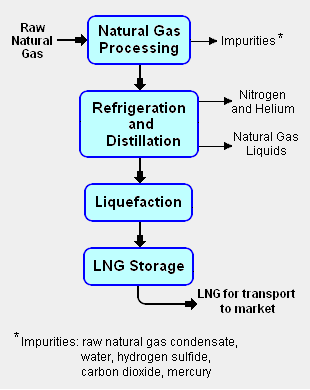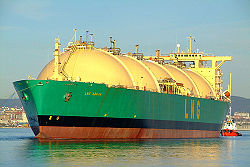User:Milton Beychok/Sandbox: Difference between revisions
imported>Milton Beychok No edit summary |
imported>Milton Beychok No edit summary |
||
| Line 1: | Line 1: | ||
{{Image|LNG block flow diagram.png|right|310px|Add image caption here.}} | |||
{{Image|LNG tanker Abuja.jpg|right|250px|LNG tanker with 5 spherical LNG tanks. Total length is 285 metres (311 yards).}} | {{Image|LNG tanker Abuja.jpg|right|250px|LNG tanker with 5 spherical LNG tanks. Total length is 285 metres (311 yards).}} | ||
{{Image|LNG Terminal.jpg|right|325px|LNG storage tanks in LNG terminal at Yokohama, Japan.).}} | {{Image|LNG Terminal.jpg|right|325px|LNG storage tanks in LNG terminal at Yokohama, Japan.).}} | ||
Revision as of 17:32, 19 February 2011
Liquefied natural gas or LNG is natural gas (predominantly methane, CH4) that has been converted into liquid form for ease of transport and storage..
The liquefication process involves removal of certain components, such as dust, acid gases, helium, water, and heavy hydrocarbons, which could cause difficulty downstream. The natural gas is then condensed into a liquid at close to atmospheric pressure by cooling it to approximately -162 °C (260 °F)
The reduction in volume makes it much more cost efficient to transport over long distances where pipelines do not exist. Where moving natural gas by pipelines is not possible or economical, it can be transported by specially designed cryogenic sea vessels (LNG carriers) or cryogenic road tankers.


